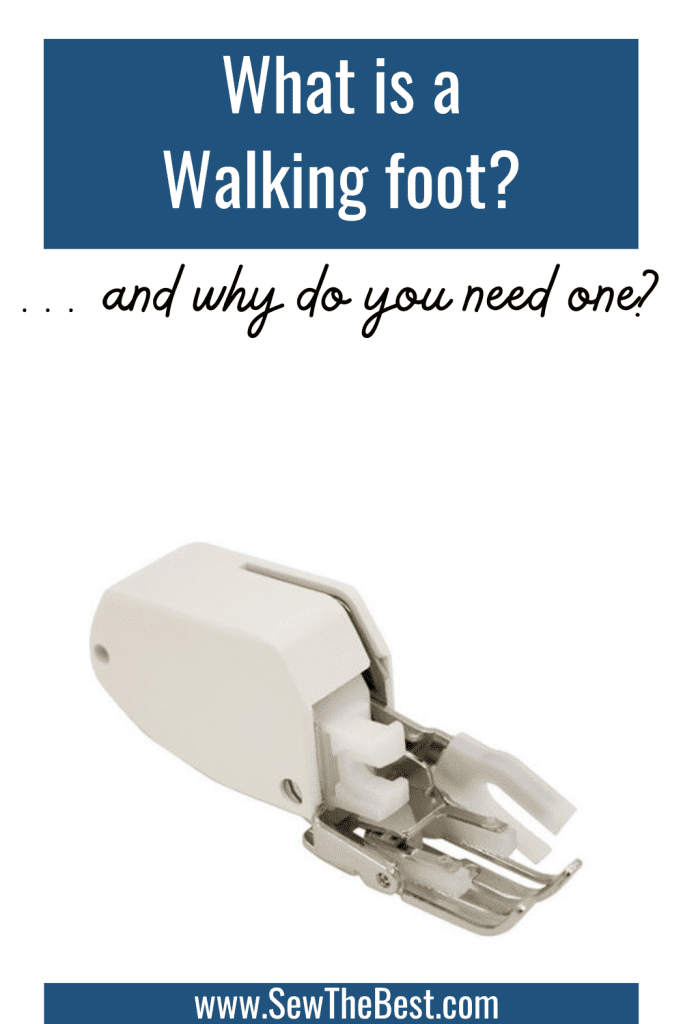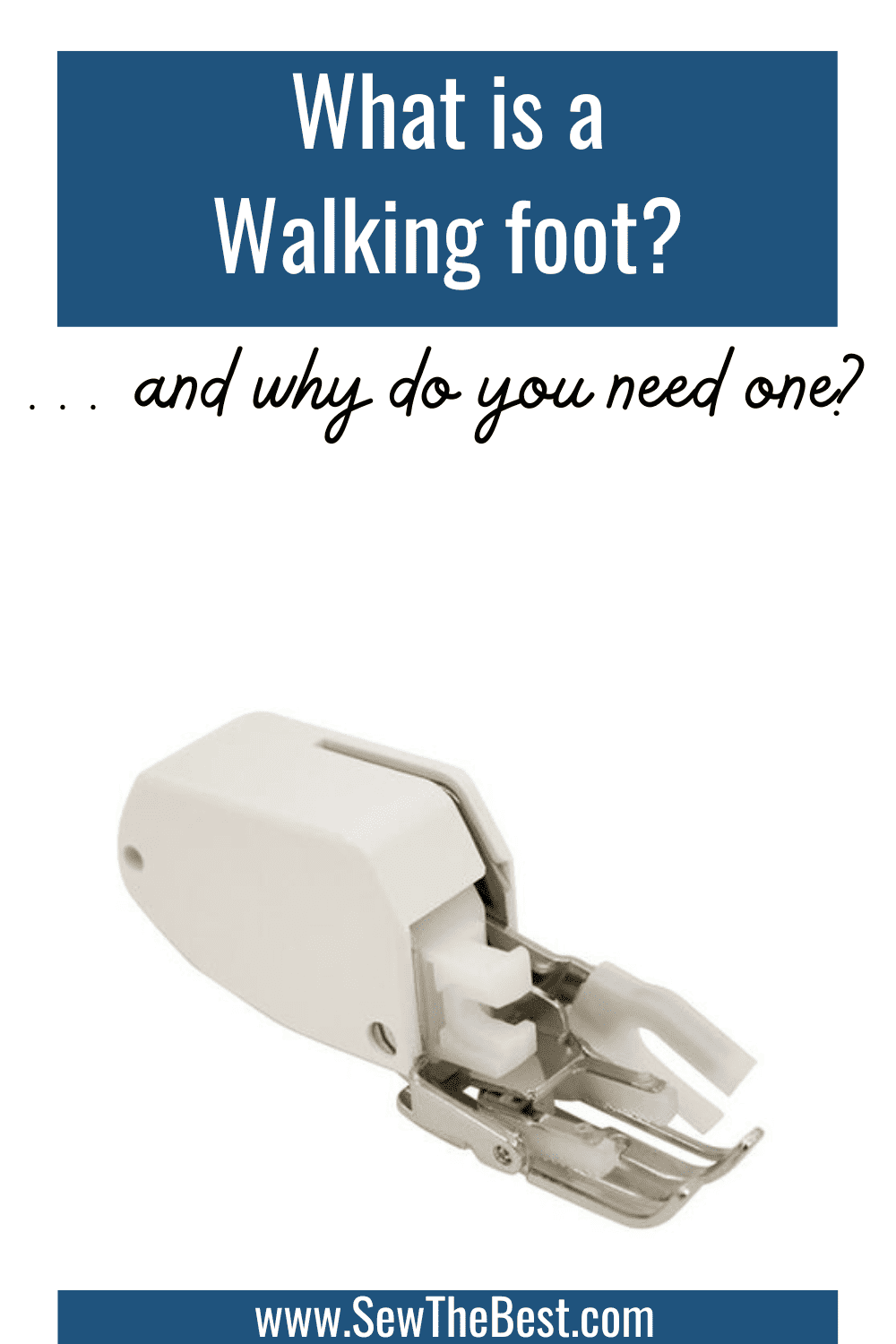If you’re someone who enjoys sewing or is interested in learning more about sewing techniques, understanding the walking foot is essential. In this article, we’ll delve into the world of sewing machine accessories and explore the significance of the walking foot. Whether you’re a seasoned seamstress or a beginner, knowing how and when to use a walking foot can greatly enhance your sewing projects. So, let’s unravel the mystery behind this valuable tool and discover how it can make a real difference in your sewing endeavors. If you’ve ever wondered what a walking foot is and why it matters, you’re in the right place. Let’s get started!

If you’re in a hurry (or just curious!) –
✅ Check deals on our favorite walking feet


What is a Walking Foot?
A walking foot, also known as an even-feed foot, is a specialized sewing machine attachment designed to tackle a common issue faced by sewers – fabric shifting. It works in harmony with your sewing machine’s feed dogs to ensure that multiple layers of fabric move through the machine evenly. The walking foot features its set of feed dogs, which synchronizes with the machine’s lower feed dogs, creating two sets of feed dogs working together. This dual-feed system prevents the top layer of fabric from shifting or stretching more than the bottom layer, leading to a smooth and consistent feed. This unique mechanism allows you to sew various challenging fabrics, such as quilts, leather, vinyl, or slippery materials, with ease and precision. By maintaining an even feed, the walking foot ensures that your stitches remain uniform, producing professional-looking results for your sewing projects.
When to use a Walking Foot
Knowing when to use a walking foot can significantly enhance your sewing experience. This versatile accessory is ideal for various sewing projects where fabric movement needs to be controlled to achieve precise and neat stitches. Here are some common types of projects where a walking foot proves indispensable:
- Quilting: Quilting involves stitching multiple layers of fabric and batting together. Using a walking foot ensures that all layers move uniformly, preventing puckering or shifting, and helps maintain the integrity of your quilt design.
- Sewing Knits and Stretchy Fabrics: Working with knits, jersey, or other stretchy fabrics can be challenging, as they tend to stretch and distort while sewing. A walking foot comes to the rescue by evenly feeding these materials, resulting in smooth and well-aligned seams.
- Sewing Multiple Layers: When sewing projects with thick or multiple layers of fabric, such as bags, wallets, or upholstery, a walking foot ensures that the layers stay aligned, preventing uneven stitching and ensuring the project’s durability.
- Leatherworking: Sewing leather requires a steady and controlled feed to prevent slipping or bunching. The walking foot’s precise feeding mechanism allows you to create clean and professional leather stitches.
- Pattern Matching: When working on projects with patterns that need precise alignment, like plaid or stripes, the walking foot assists in keeping the fabric in place, making pattern matching much more manageable.
- Topstitching: Achieving consistent and straight topstitching can be challenging, especially on thicker fabrics. The walking foot helps maintain an even stitch length, resulting in neat and uniform topstitching.
By recognizing the appropriate situations to use a walking foot, you can elevate the quality of your sewing projects and ensure a more enjoyable and satisfying sewing experience
Caring for your Walking Foot
To keep your walking foot performing effectively, regular maintenance is crucial. After each sewing project, clean the foot by gently removing lint and debris. Avoid harsh chemicals and opt for mild soap and water instead. Follow your sewing machine’s manual for lubrication guidelines and store the foot in a clean, dry place when not in use. Regularly inspect for damage and handle it with care to ensure smooth and even feed for all your sewing projects. With proper maintenance, your walking foot will continue to provide reliable results and enhance your sewing experience.
FAQ
What is the difference between a walking foot and a regular foot?
The main difference between a walking foot and a regular foot lies in their feeding mechanisms. A regular foot relies solely on the lower feed dogs of the sewing machine to move the fabric through, which can lead to slippage, especially when working with multiple layers or challenging fabrics. In contrast, a walking foot has its set of upper feed dogs that work in sync with the machine’s lower feed dogs. This dual-feed system ensures even and consistent fabric movement, preventing shifting and producing more precise and professional stitches.
Do I really need a walking foot?
While a walking foot is not always essential, it is a valuable tool that can greatly improve your sewing experience, especially for specific projects and fabric types. If you frequently work with quilts, stretchy fabrics, leather, or multiple layers of fabric, a walking foot can make a significant difference in achieving better results. It provides added control and helps avoid common sewing challenges like fabric distortion and uneven stitches. If you engage in these types of projects frequently, investing in a walking foot can be highly beneficial.
What’s the difference between a walking foot and a free-motion foot?
The primary difference between a walking foot and a free-motion foot lies in their purposes and functionality. As mentioned earlier, a walking foot is used for projects where controlled fabric feeding is essential to prevent shifting. It’s ideal for quilting, sewing knits, and working with heavy fabrics. On the other hand, a free-motion foot is designed for creative sewing techniques like free-motion quilting, embroidery, and darning. Unlike the walking foot, the free-motion foot doesn’t engage the feed dogs at all, allowing the sewer to move the fabric freely in any direction to create intricate designs and patterns.
How do I attach a walking foot to my sewing machine?
Attaching a walking foot to your sewing machine is usually a straightforward process. Refer to your sewing machine’s manual for specific instructions, as the attachment method can vary depending on the machine’s make and model. In most cases, you’ll need to remove the regular presser foot and then align and secure the walking foot in its place. Some machines may require additional adjustments or using a specific adapter for compatibility. Always follow the manufacturer’s guidelines to ensure proper installation.
Can I use a walking foot for all sewing projects?
While a walking foot is a valuable tool for many sewing projects, there may be instances where it is not necessary or suitable. For lightweight and non-layered fabrics with minimal shifting issues, a regular presser foot may suffice. Additionally, for projects that involve intricate free-motion techniques, a free-motion foot would be more appropriate. However, for projects involving quilting, heavy fabrics, or multiple layers, using a walking foot is highly recommended for achieving the best results.
Can I use a walking foot for different sewing machine brands?
In most cases, walking feet are designed to be compatible with various sewing machine brands. However, it is essential to ensure that the walking foot you choose is compatible with your specific sewing machine model. Check the foot’s packaging or consult with your sewing machine manufacturer to verify compatibility. Some machines may require specific walking foot models or adapters to work seamlessly.
How do I troubleshoot common issues when using a walking foot?
While using a walking foot can significantly improve sewing outcomes, you may encounter some challenges occasionally. Common issues may include uneven stitching, skipped stitches, or difficulty sewing certain fabrics. In such cases, review your sewing machine’s manual for troubleshooting tips specific to your machine and walking foot. Adjusting the stitch length, thread tension, or walking foot pressure can often resolve these issues. Additionally, ensuring proper maintenance of the walking foot, such as regular cleaning and lubrication, can contribute to smoother sewing experiences.
Summary
In conclusion, a walking foot is a valuable tool that ensures smooth and precise fabric movement in various sewing projects. Its dual-feed mechanism prevents shifting and distortion, making it ideal for quilting, working with stretchy fabrics, and sewing multiple layers. Regular maintenance, including gentle handling and cleaning, keeps the walking foot in excellent condition for consistent results.
While a walking foot is not always necessary, it greatly improves sewing experiences for specific projects. For intricate free-motion techniques, other specialized feet may be more suitable. Embracing the advantages of a walking foot, whether you’re a seasoned sewist or a beginner, will undoubtedly lead to professional and rewarding sewing outcomes. So, equip yourself with a walking foot, explore its benefits, and enjoy the seamless journey of sewing with precision and ease. Happy sewing!
Related Posts:
- Beginner sewer looking for more sewing tools? Check out the best sewing tools for beginners.
